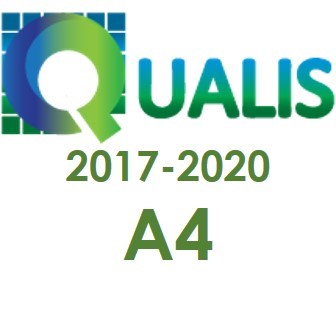Produção de concreto verde pela substituição parcial de pó de pedra por pet
Palavras-chave:
Concreto Verde. Construção Civil. PET. Pó de Pedra.Resumo
Este artigo de iniciação científica propõe a produção e a avaliação de desempenho de concretos verdes que possuem uma substituição parcial do agregado fino de pó de pedra por resíduos de tereftalato de polietileno (PET). A produção de concreto verde objetiva minimizar a quantidade de PET pós-consumo descartados em aterros, ou incinerados, pelo seu uso como material de consumo na indústria da construção civil. Os concretos verdes produzidos com substituição parcial de 10% e de 15% de agregado miúdo de pó de pedra por PET alcançaram a resistência à compressão e densidade que possibilita os seus usos para fins estruturais.
Downloads
Referências
ABNT NBR 5738:2015 Versão Corrigida:2016. Concrete - Procedure for molding and curing concrete test specimens. https://www.abntcatalogo.com.br/norma.aspx?ID=357453
ABNT NBR 5739:2018. Concrete - Compression test of cylindrical specimens. https://www.abntcatalogo.com.br/norma.aspx?ID=398444
ABNT NBR 6118:2014 Versão Corrigida:2014. Design of concrete structures — Procedure. https://www.abntcatalogo.com.br/norma.aspx?ID=317027
ABNT NBR 6118:2014 Versão Corrigida:2014. Design of concrete structures — Procedure. https://www.abntcatalogo.com.br/norma.aspx?ID=317027
ABNT NBR 9781: 2013. Concrete paving units — Specification and test methods. https://www.abntcatalogo.com.br/norma.aspx?ID=194630
ABNT NBR NM 248:2003. Aggregates - Sieve analysis of fine and coarse aggregates. https://www.abntcatalogo.com.br/norma.aspx?ID=2979
ALANI, Aktham H. et al. Durability performance of a novel ultra-high-performance PET green concrete (UHPPGC). Construction and Building Materials, v. 209, p. 395-405, 2019. DOI: https://doi.org/10.1016/j.conbuildmat.2019.03.088
ASTM C127-15, Standard Test Method for Relative Density (Specific Gravity) and Absorption of Coarse Aggregate, ASTM International, West Conshohocken, PA, 2015, www.astm.org
ASTM C143 / C143M-15a, Standard Test Method for Slump of Hydraulic-Cement Concrete, ASTM International, West Conshohocken, PA, 2015, www.astm.org
ASTM C143 / C143M-15a, Standard Test Method for Slump of Hydraulic-Cement Concrete, ASTM International, West Conshohocken, PA, 2015, www.astm.org
ASTM C150 / C150M-18, Standard Specification for Portland Cement, ASTM International, West Conshohocken, PA, 2018, www.astm.org
ASTM C1585-13, Standard Test Method for Measurement of Rate of Absorption of Water by Hydraulic-Cement Concretes, ASTM International, West Conshohocken, PA, 2013, www.astm.org
ASTM C192 / C192M-18, Standard Practice for Making and Curing Concrete, Test Specimens in the Laboratory, ASTM International, West Conshohocken, PA, 2018, www.astm.org
ASTM C192 / C192M-18, Standard Practice for Making and Curing Concrete Test Specimens in the Laboratory, ASTM International, West Conshohocken, PA, 2018, www.astm.org
ASTM C33 / C33M-18, Standard Specification for Concrete Aggregates, ASTM International, West Conshohocken, PA, 2018, www.astm.org
ASTM C39 / C39M-18, Standard Test Method for Compressive Strength of Cements, ASTM International, West Conshohocken, PA, 2018, www.astm.org
ASTM C496 / C496M-17, Standard Test Method for Splitting Tensile Strength of Cylindrical Concrete Specimens, ASTM International, West Conshohocken, PA, 2017, www.astm.org
ASTM C595 / C595M-18, Standard Specification for Blended Hydraulic Cylindrical Concrete Specimens, ASTM International, West Conshohocken, PA, 2018, www.astm.org
ASTM C642-13, Standard Test Method for Density, Absorption, and Voids in Hardened Concrete, ASTM International, West Conshohocken, PA, 2013, www.astm.org
ASTM C936 / C936M-18, Standard Specification for Solid Concrete Interlocking Paving Units, ASTM International, West Conshohocken, PA, 2018, www.astm.org
BARBERA, Antonio C.; VYMAZAL, Jan; MAUCIERI, Carmelo. Greenhouse gases formation and emission. Encyclopedia of Ecology. 2a. ed., 2019, p. 329-333. DOI: https://doi.org/10.1016/B978-0-12-409548-9.10895-4
FERREIRA, Carla Regina et al. Comparative Study About Mechanical Properties of Structural Standard Concrete and Concrete with Addition of Vegetable Fibers. Materials Research, v. 20, p. 102-107, 2017. DOI: https://dx.doi.org/10.1590/1980-5373-mr-2016-0905
FOTI, Dora. Recycled waste PET for sustainable fiber-reinforced concrete. In: Use of Recycled Plastics in Eco-Efficient Concrete. Woodhead Publishing, 2019. p. 387-410. DOI: https://doi.org/10.1016/B978-0-08-102676-2.00018-9
ISLAM, Rafiquel; HYE, Md Abdul. Metallurgical treatment processes of metals (Fe and Steel, Al, Cu, Au) and their detrimental environmental issues-A mini review. International Journal of Scientific and Research Publications, v. 8, n. 5, p. 677-679, 2018. DOI: http://dx.doi.org/10.29322/IJSRP.8.5.2018.p7782
LIEW, K. M.; SOJOBI, A. O.; ZHANG, L. W. Green concrete: Prospects and challenges. Construction and building materials, v. 156, p. 1063-1095, 2017. DOI: https://doi.org/10.1016/j.conbuildmat.2017.09.008
MC-Bauchemie. Admixture Solutions for the Ready-Mixed Concrete Industry. MC-Bauchemie Müller GmbH & Co. KG. Am Kruppwald 1-8. 46238 Bottrop. Germany, 2019. https://www.mcbauchemie.com/assets/downloads/brochures/Readymix_Concrete_Industry_ MC-Bauchemie.pdf
MC-PowerFlow 1080 - High-Performance Superplasticizer of the new MCGeneration. MC-Bauchemie Müller GmbH & Co. KG. Am Kruppwald 1-8. 46238 Bottrop. Germany. 2019. https://www.mc-bauchemie.com.br/assets/downloads/products/br/fichas_tecnicas/MCPowerFlow%201080.pdf
OBLA, Karthik H. What is green concrete?. The Indian Concrete Journal, v. 24, p. 26-28, 2009. https://www.nrmca.org/research_engineering/Documents/25.pdf
RAHIMI, R. S.; Nikbin, IM; Allahyari, H.; Habibi T., S. Sustainable approach for recycling waste tire rubber and polyethylene terephthalate (PET) to produce green concrete with resistance against sulfuric acid attack. J. Clean. Prod, v. 126, p. 166-177, 2016. DOI: https://doi.org/10.1016/j.jclepro.2016.03.074
TRENT, S. MNL32-5TH, Test Sieving Methods: Guidelines for Establishing Sieve Analysis Procedures; 5th Edition, 2014. www.astm.org
TUCKETT. R. Greenhouse Gases. Reference Module in Chemistry, Molecular Sciences and Chemical Engineering. Encyclopedia of Analytical Science, 3a. ed., 2019, p. 362-372. DOI: https://doi.org/10.1016/B978-012-409547-2.14031-4
Arquivos adicionais
Publicado
Como Citar
Edição
Seção
Licença
Copyright (c) 2021 Revista Brasileira de Iniciação Científica

Este trabalho está licenciado sob uma licença Creative Commons Attribution-NonCommercial-NoDerivatives 4.0 International License.




